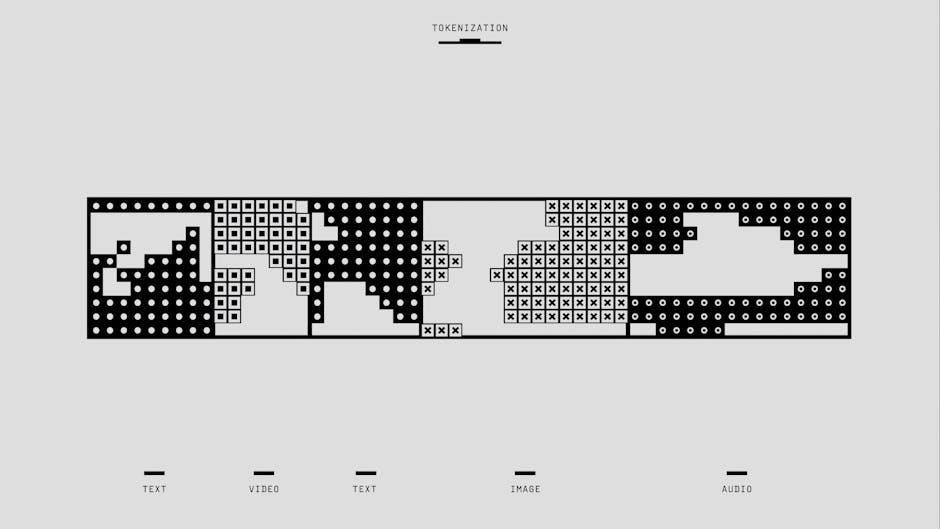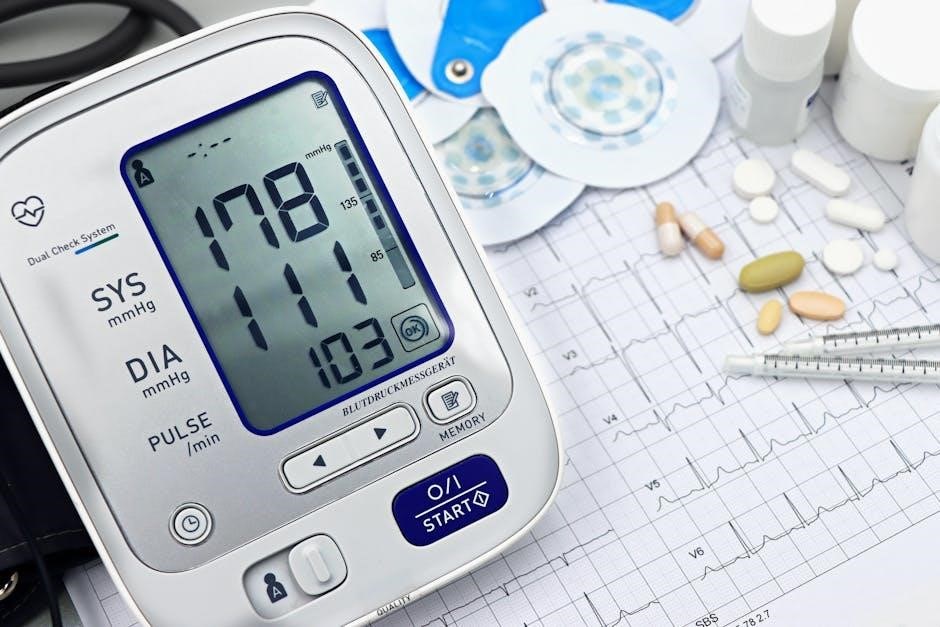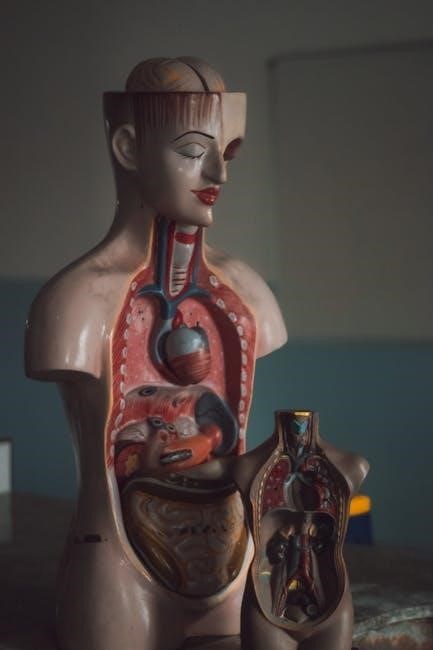The cardiovascular system, comprising the heart, blood vessels, and blood, is crucial for delivering oxygen and nutrients. It sustains life by maintaining proper bodily functions and overall health.
Overview of the Cardiovascular System
The cardiovascular system is a complex network responsible for transporting blood throughout the body. It consists of the heart, blood vessels, and blood, working together to supply oxygen, nutrients, and hormones to cells while removing waste products. The heart acts as a pump, propelling blood through arteries, veins, and capillaries. This system is vital for maintaining cellular function, supporting immune responses, and regulating body temperature, ensuring overall health and survival.
Importance of the Cardiovascular System in the Body
The cardiovascular system is essential for delivering oxygen and nutrients to cells while removing waste products. It plays a critical role in maintaining proper bodily functions, such as regulating body temperature and supporting immune responses. By transporting hormones, it ensures communication between different organs. A healthy cardiovascular system is vital for overall well-being, enabling physical activity, mental performance, and survival. Its dysfunction can lead to severe health issues, emphasizing the need for proper care and maintenance.
Structure of the Cardiovascular System
The cardiovascular system consists of the heart, blood vessels, and blood. The heart is a muscular organ with chambers and valves, pumping blood through arteries, veins, and capillaries.
Heart: Chambers and Valves
The heart contains four chambers: the right and left atria (upper chambers) and the right and left ventricles (lower chambers). Blood flows through these chambers sequentially. Valves, such as the mitral, tricuspid, pulmonary, and aortic valves, ensure blood moves in one direction, preventing backflow. This precise structure enables efficient pumping of blood throughout the body, maintaining proper circulation and oxygen delivery to tissues.
Blood Vessels: Arteries, Veins, and Capillaries
Blood vessels form a network for blood circulation, consisting of arteries, veins, and capillaries. Arteries carry oxygen-rich blood away from the heart, while veins return oxygen-depleted blood to it. Capillaries, tiny vessels, enable nutrient and oxygen exchange between blood and tissues. Arteries are thick-walled to handle high pressure, veins have one-way valves to prevent backflow, and capillaries allow for diffusion of substances essential for cellular function, ensuring efficient transport and delivery throughout the body.
Blood: Components and Functions
Blood is a vital fluid consisting of plasma, red blood cells, white blood cells, and platelets. Plasma, the liquid component, transports nutrients, hormones, and waste products. Red blood cells carry oxygen throughout the body, while white blood cells play a crucial role in immunity by fighting infections. Platelets are essential for blood clotting, preventing excessive bleeding. Together, these components ensure proper oxygen delivery, immune defense, and maintenance of overall health, making blood indispensable for survival and bodily functions.

Function of the Cardiovascular System
The cardiovascular system functions to pump blood, delivering oxygen and nutrients to tissues while removing waste. It regulates body temperature and transports hormones, sustaining life.
Blood Circulation and Oxygen Delivery
Blood circulation is the process by which the cardiovascular system transports oxygenated blood to tissues and deoxygenated blood to the lungs. Oxygen-rich blood from the lungs enters the heart, which pumps it through arteries to the body. Capillaries facilitate the exchange of oxygen, nutrients, and waste products with tissues. Veins return deoxygenated blood to the heart, completing the cycle. This essential function ensures cells receive the oxygen and nutrients needed for survival, while waste products are efficiently removed.
Regulation of Body Temperature
The cardiovascular system plays a vital role in regulating body temperature. Blood circulation helps distribute heat throughout the body. When the body temperature rises, blood flow increases to the skin’s surface, allowing excess heat to escape. Conversely, in colder conditions, blood vessels constrict, reducing heat loss and maintaining core temperature. This thermoregulatory function is essential for maintaining homeostasis and ensuring proper cellular and organ functions. It works in tandem with the nervous system to keep the body’s temperature balanced and stable.
Transportation of Nutrients and Hormones
The cardiovascular system efficiently transports nutrients and hormones throughout the body. Nutrients, absorbed from the digestive system, are carried by blood to cells, ensuring proper nourishment. Hormones, produced by endocrine glands, are also conveyed via blood to their target organs, regulating various physiological processes. This vital function supports metabolism, growth, and overall bodily functions, highlighting the system’s role in maintaining health and homeostasis through precise delivery mechanisms.
Blood Circulation Process
The cardiovascular system circulates blood throughout the body, supplying oxygen and nutrients while removing waste. This process sustains life by maintaining proper tissue function and overall health.
Pulmonary Circulation
Pulmonary circulation refers to the movement of blood between the heart and lungs. Deoxygenated blood from the right ventricle flows through the pulmonary artery to the lungs, where it absorbs oxygen and releases carbon dioxide. Oxygen-rich blood then returns to the left atrium via the pulmonary veins. This process is vital for oxygenating blood and maintaining proper respiratory and cardiovascular function, ensuring the body’s tissues receive the oxygen they need to function effectively and efficiently.
Systemic Circulation
Systemic circulation transports oxygen-rich blood from the left ventricle to the body and returns deoxygenated blood to the right atrium. The aorta, the largest artery, distributes blood to smaller arteries, which branch into capillaries. Oxygen and nutrients diffuse into tissues, while waste products enter the bloodstream. Blood returns via veins to the vena cava, completing the cycle. This process sustains cellular function, delivers essential nutrients, and maintains overall bodily homeostasis, ensuring optimal health and energy distribution throughout the body.
Circulatory Pathways
Blood flows through the heart and lungs in a precise sequence. Oxygen-depleted blood enters the right atrium, moves to the right ventricle, and flows to the lungs for oxygenation. Oxygen-rich blood returns to the left atrium, then to the left ventricle, which pumps it into the aorta. From there, it circulates to the body via arteries, reaching capillaries for nutrient exchange. Deoxygenated blood collects in veins, returning to the heart through the vena cava, completing the circulatory cycle efficiently and continuously throughout life.

Heart Health and Maintenance
Maintaining heart health requires a balanced diet, regular exercise, stress management, and adequate sleep. Avoid smoking and limit alcohol to promote cardiovascular well-being and prevent disease effectively.
Diet and Nutrition for a Healthy Heart
A well-balanced diet is essential for maintaining heart health. Focus on consuming fruits, vegetables, whole grains, lean proteins, and healthy fats, such as those found in fish and nuts. Limit intake of processed foods, saturated fats, cholesterol, and excessive sodium. Reducing added sugars and refined carbohydrates helps manage blood pressure and weight. Staying hydrated and avoiding excessive alcohol consumption further supports cardiovascular well-being. A heart-healthy diet can significantly reduce the risk of chronic diseases and promote overall longevity.
Exercise and Physical Activity
Regular physical activity is vital for cardiovascular health. Engage in at least 150 minutes of moderate-intensity aerobic exercises, such as walking or cycling, weekly. Strength training and high-intensity interval training can also enhance heart function. Exercise improves blood circulation, strengthens the heart muscle, and lowers blood pressure. It also aids in weight management and reduces cholesterol levels, minimizing the risk of heart disease. Incorporating physical activity into daily routines promotes overall well-being and longevity.
Stress Management and Sleep
Managing stress and ensuring adequate sleep are crucial for heart health. Chronic stress increases cortisol levels, potentially raising blood pressure and straining the cardiovascular system. Poor sleep quality and duration can disrupt bodily functions, including blood pressure regulation and inflammation control. Aim for 7-8 hours of sleep daily and practice stress-reduction techniques like meditation or deep breathing to maintain a healthy cardiovascular system and overall well-being.
Common Cardiovascular Diseases
Common cardiovascular diseases include heart failure, coronary artery disease, and hypertension. These conditions often result from poor lifestyle choices and require timely medical intervention for effective management.
Heart Failure
Heart failure occurs when the heart cannot pump enough blood to meet the body’s needs. It can result from high blood pressure, coronary artery disease, or heart valve issues. Symptoms include fatigue, swelling, and shortness of breath. Early diagnosis through echocardiograms and ECGs is crucial. Treatment may involve medications, lifestyle changes, or surgical interventions like pacemakers or heart transplants. Managing the condition requires a comprehensive approach to improve quality of life and prevent further complications.
Coronary Artery Disease
Coronary artery disease occurs when plaque builds up in the arteries, narrowing them and reducing blood flow to the heart. It can cause chest pain, shortness of breath, or heart attacks. Risk factors include high cholesterol, hypertension, diabetes, and smoking. Early detection through angiography or ECG is vital. Treatment may involve medications, angioplasty, or bypass surgery. Lifestyle changes, such as a healthy diet and regular exercise, can help manage and prevent the progression of this condition.
Hypertension
Hypertension, or high blood pressure, is a major risk factor for cardiovascular diseases. It occurs when the force of blood against artery walls is consistently too high. Primary hypertension develops over time due to factors like diet, stress, and obesity, while secondary hypertension is caused by underlying conditions such as kidney disease or hormonal imbalances. Symptoms may include headaches or dizziness but often go unnoticed until severe. Diagnosis involves regular blood pressure checks, and management may require lifestyle changes or medication to prevent complications like heart failure or stroke.

Diagnostic Techniques
Diagnostic techniques for the cardiovascular system include electrocardiograms (ECG) to monitor heart rhythms, echocardiograms for heart structure imaging, and angiography to visualize blood vessels, aiding in early disease detection and management.
Electrocardiogram (ECG)
An electrocardiogram (ECG) is a non-invasive test that measures the electrical activity of the heart. It detects arrhythmias, ischemia, and other cardiac conditions by recording electrical signals through electrodes placed on the skin. The ECG provides essential information about heart rate, rhythm, and the electrical conduction system, helping diagnose conditions like atrial fibrillation or ventricular hypertrophy. It is a critical tool in preventive care and monitoring cardiovascular health, offering insights into the heart’s functioning and potential abnormalities.
Echocardiogram
An echocardiogram is an ultrasound-based imaging test that produces detailed images of the heart’s structure and function. It uses sound waves to visualize heart chambers, valves, and blood flow, aiding in the diagnosis of conditions like valve disorders, heart failure, and congenital defects. Types include transthoracic (external) and transesophageal (internal) echocardiograms. This non-invasive tool provides critical insights into cardiac health, enabling early detection and monitoring of heart diseases, while ensuring patient safety and comfort during the procedure.
Angiography
Angiography is a diagnostic imaging technique that visualizes blood vessels and their structures. It involves injecting a contrast agent into the bloodstream, which highlights blood vessels on X-ray images, helping identify blockages, aneurysms, or malformations. Commonly used to assess coronary artery disease, angiography provides detailed insights into blood flow and vessel integrity, aiding in accurate diagnosis and treatment planning for cardiovascular conditions.

Treatment and Management
Treatment and management of cardiovascular conditions often combine lifestyle changes, medications, and surgical interventions to restore heart health and prevent further complications, improving overall well-being effectively.
Lifestyle Modifications
Lifestyle modifications are crucial for maintaining heart health and preventing cardiovascular diseases. These include adopting a balanced diet rich in fruits, vegetables, and whole grains, while reducing salt and saturated fats. Regular physical activity, such as brisk walking or swimming, helps improve circulation and overall cardiovascular function. Quitting smoking and limiting alcohol consumption are also essential steps. Additionally, managing stress through techniques like meditation or deep breathing can significantly benefit cardiovascular well-being. These changes promote long-term health and reduce the risk of complications.
Medications
Medications play a vital role in managing cardiovascular health. Statins lower cholesterol levels, reducing the risk of heart disease. Beta-blockers and ACE inhibitors help control blood pressure and heart rate, easing the heart’s workload. Antiplatelet drugs, like aspirin, prevent blood clots, while diuretics reduce fluid retention, alleviating strain on the heart. These medications, when prescribed and used correctly, significantly improve cardiovascular outcomes and help manage conditions such as hypertension and coronary artery disease, promoting overall heart health and longevity.
Surgical Interventions
Surgical interventions are critical for treating severe cardiovascular conditions. Procedures like coronary artery bypass grafting (CABG) improve blood flow to the heart. Heart transplantation replaces a diseased heart with a donor heart. Valve repair or replacement corrects faulty heart valves, ensuring proper blood flow. Aneurysm repair reinforces weakened blood vessel walls, preventing rupture. These surgeries address serious cardiovascular diseases, significantly improving patient outcomes and quality of life, offering effective solutions when other treatments are insufficient.
The cardiovascular system is vital for maintaining life, ensuring oxygen and nutrient delivery to tissues. Proper heart health through diet, exercise, and stress management prevents diseases like hypertension and coronary artery disease. Early diagnosis via ECG and echocardiogram, paired with effective treatments, enhances outcomes. Understanding this system’s structure and function fosters appreciation for its complexity and essential role in overall well-being, emphasizing the importance of proactive care and lifestyle choices to sustain a healthy heart and vascular system throughout life.



